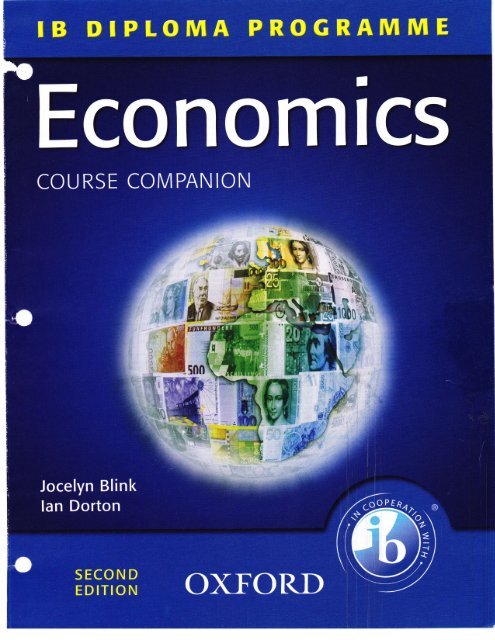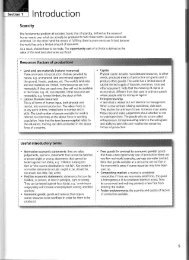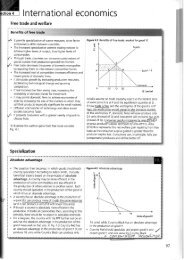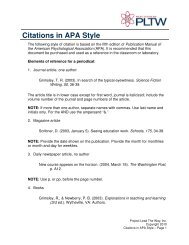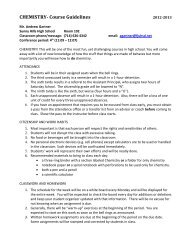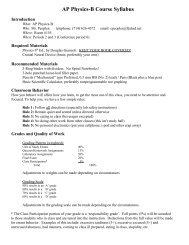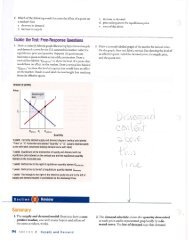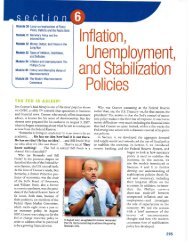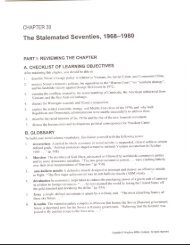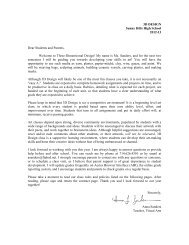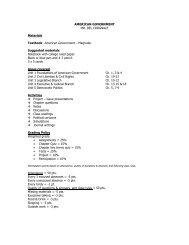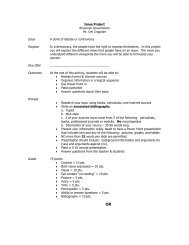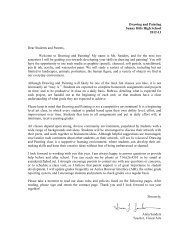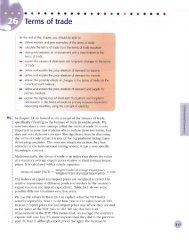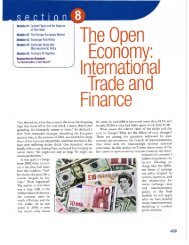IB Econ Chap 01 Foundations - Sunny Hills High School
IB Econ Chap 01 Foundations - Sunny Hills High School
IB Econ Chap 01 Foundations - Sunny Hills High School
Create successful ePaper yourself
Turn your PDF publications into a flip-book with our unique Google optimized e-Paper software.
OXFORD<br />
T/NIVERSITY PRESS<br />
Great Clarendon Street, Oxford OX2 6Dp<br />
Oyford Univer.iry Press i\ a departmenl otlhe Univcr5it) ofOxlord.<br />
It furthers the University s objective ofexcellence in research. scholarship,<br />
and education by publishing worldwide in<br />
Oxford NewYork<br />
Auckland CapeTowr Daressalaam HongKong Karachi<br />
Kualalumpur Madrid Melbourne Mexicocitv-Nairobi<br />
Neh Delhi 5hanghri Taipei Toronro<br />
With oflices in<br />
Argentina Austria Brazil Chile Czech Republic lrance Greece<br />
Cuatcmala Hungary lraly Japan<br />
poland portugal Singapore<br />
South Korea Switzerland Thailand Turkey Ukriine Viitiram<br />
O Coplright Oxford University press<br />
The moral rEhts ofthe authors have been asserted<br />
Database right Oxford University press (maker)<br />
First published 2<strong>01</strong>1<br />
All rights reseNed. No part ofthis publication may be reproduced,<br />
stored in a retileval system. or transmitted, in any form or by any Deans,<br />
without the pdor permission in miting ofOxford University press,<br />
or as expressly permitted by law, or under terms agreed witir the appropriate<br />
reprographics rights organization. Enquiries coDceming reprociuction<br />
outside the scope ofthe above should be sent to rhe Ridhtsbepartmenr,<br />
Oxford Universiry Press, at the address above<br />
You rnust not circulate this book in any other binding or cover<br />
and you must inpose this same condition on any acq-uirer<br />
British Library Cataloguing in publication Data<br />
Data available<br />
ISBN: 978-0-19-918499-6<br />
109476s432<br />
Pdnted in Singapore by KHL Prinring Co pte<br />
Paper used in thc ploduction ofthis book is a natural, recyclable product nade from wood<br />
grown in sustainable forests. The manufacturing proccss ionforms to the environDeDtal<br />
regulations ofthe counrry ofodgin.<br />
Acloowledgments<br />
C-over; Inage Source/Alamy; p2: Hulron Archive/Getty hlages: p3: NASA: p12: Imagno/<br />
Hulton Archire/Getty Images; p15: Keysrone, Martial Trezzlni/A! photo; p22: Dwori/<br />
Shutterstock: P24: Bettmannlcorbis; ?28: cassiede alain/Shuttersrock; p3S: MarselSi/<br />
Stlurresrock: P53: Alron Luhr/phorolibrary; p70: RUPA TOTTON MILLS (EpZ) LTD ; pSTt:<br />
woilgJng Raltay/Reuters; P87b: Stephen Mc5weeny/Shunerstock: p99: Jcmma Jones/AlJmy:<br />
P103: Chdstopher Elwell/Shutterstocki p115: James M phelps, Jr/Shutt;rstock'ptzz: Kevin<br />
Foy/Rex Features; P137: Heinz-peter Bader/Reuters: pt39: Ferenc Cegledi/Shutterstock:<br />
P146: Sonny Meddle/Rex Features; pl49t: POOL NeqReuters: p149b: Tommy Trcnchard/<br />
Alamy; P150: )vons2/Shutterstockj p1S2: Jin parkin/Shutterstock: p159: Science Museun/<br />
Science & Society Pjctrre Library; p-l66: Cheryl Casey/Dreamsrime: p174: Shaun Hensher/<br />
Shutterstock; P176: Vibrant Image Studio/Shutterstoik; p187: Rob Bartee/Alamy: p188:<br />
Andrew Parker/Alamy: Pl911: Sarah Flanagan/Rex Features: p191r: Angela Rowiings/Ap<br />
Photo; P196t: Appleton/Alamy; P196b: Walter Sroneman/Stringer/Hulrin Archive/aetty<br />
ITaqes; P204: lsopixBex Features; P2l2: DWImages Norrhern heland/Alamy; p2i1: K;irh<br />
Leighton/Alamy; P223: Keith Leighton/Alamy: p22s: David n Madden/Shutteistock; p232:<br />
C_eorge Rose/Contdbutor/Cetry Images Enrenajnnenvcerry lmages: p235: Joe cough/<br />
Shutterstock; P24,1: Ssguy/Shrrtersrock; p264: Hulron Archive/Gery Images; p265: World<br />
Trade O_rganization; P268: John Henshall/Alamy: P282: Vini(ius Tupinarn"ba/Shutterstock:<br />
P28^4: MCC North_London]Rex Features; p290: Christopher Rawlins/Dreansiime; p294: Feng<br />
Yu/Shutter$ocki_P295t1: Ollirg/Shuttersrock; p295bl: Malcolm park/Alamy; p295tr: Jerome<br />
Delay/AP Photo; P295m: Jerome Delay/Ap phoro: p29sbn Srephen Srreet/Fhototibrary: p310:<br />
4x5 Coll PR?roductions 1gg5/Photolibrary; p311i Jochen Tack/phorolibraryt p312: Elena<br />
Schweitzer/Shunerstock; P314: Wolfgang Diederich/photolibr;ry; p324: Jo;gen Schltte/<br />
Photolibrary; P331: Touhig Sion/Corbis; p336: Ron Giling/phorotlbrary; F338: Romeo<br />
Ranoco/Reuters; P339t: Rod Mclean/Alamy; p339b: lrawie Sriplakich/Alamy; p340: Sylvaine<br />
Poitau/Alamy; P346: Chris Martin Bahr/Rex Fearures; p347: Aciion press/Rei leaturei; p358:<br />
Jean-Marc Giboux/Contributor/cetty Inages News/cetty Images; p359: prism68/<br />
Shutterstock: P360: E.Westmacott/Atany; p364: Borderlands/Alamy; p370: pierre_yves<br />
Babelon/Shurerstock P373: Jim West/photolibraryl p376: Helene itogers/Afi Directors &<br />
Ttip; P379: I<strong>IB</strong> Photo/Photolibrary; P395r Alistair Linford,iR.ex Featurei.<br />
We are grateful to the following for permission to reprint copyright matedal:<br />
Tables iiom the Office ofNational Statistics Consumer prices lndex and Retails prices<br />
Index: 'The 2<strong>01</strong>0 Basket of coods and SeNices', philip Cooding, Crown O 2<strong>01</strong>0. are used<br />
under the terms ofthe Open Governnent Licence.<br />
The Europem Commission for extract fion Europa press release 12 January 2009,<br />
copydght O European Union 2009.<br />
The Financial Times for quentin Peel: 'cerman business sentiment in three-year high',<br />
Financial Ti,mes , 23 .7 .2<strong>01</strong>0<br />
Guardian News md Media Ltd for Katie Allen: 'UK cunent account deficit widens as<br />
imports rocket', The Guardian, 13.s.2070, coplright O Guardian News and Media Lrd 2<strong>01</strong>0:<br />
and Jason Burke & Saad Hammadi: 'Dhaka garment workers in violent protesrts over low<br />
pay', The Cuardian. 31.7.2<strong>01</strong>0, copyright O Guardian News and Media Lta 2<strong>01</strong>0.<br />
Intenational Baccalaureate OTganization for use of example questions iiom previous<br />
exammatlon papers.<br />
Icngsport Times for editorial 'Cigarette tu hike would benefit Tennessee residents, The<br />
Kiflgspot't Times. 20.3.2006.<br />
Moneyweek Ltd for'Headwinds will buffet Germany'. w.moneylveek.com, 76.?.2070.<br />
News Intemational SJmdication for Leo Lewis & David Robefison: .Copper breaks<br />
through $8,000 per tonne banier but hot metal pilces may soon cool', Tiejimes, j. .2O'IO.<br />
coplright @ The Tines 2<strong>01</strong>0.<br />
Oxford Uriversity Press for extract ft om Delelopment as Freedofi by ADartya Sen (OUp.<br />
1999).<br />
Palgrave Macmillu for sections iiom Indicator Tables from the United Nations<br />
Development Programrae Human D\elapment Report 2009.<br />
Professor Friedrich Schneider for tables fiom Discussion paper 1431, December 2004.<br />
statistics cmada for naterial and data reproduced fiom the statistics canada website.<br />
TelegTaph Media Grcup Ltd for Bonnie Malkin: .Huge itrcrease in demand fdr hansters<br />
in China' Ihe ltlegroph:12.2.2oo8,<br />
World Trade Orgmization (WTO)<br />
World Trade Organisation integrated<br />
WRENmedia for 'Focus on Benin'.<br />
We have tried to trace and contact all<br />
publishers will be pleased to rectii/<br />
Ihe publishers would like to thank<br />
com) for the interactive diagrams on t<br />
Authors<br />
lan Dofton has been teaching <strong>IB</strong><br />
taught iD the t[( and Singapore md is<br />
in Vienna. He is a hincipal Examiner<br />
JocebD Blink has been teachitrg <strong>IB</strong> Di<br />
taught in Canada, Nigcria and olnen<br />
Principal lxaDriler for <strong>IB</strong> <strong>Econ</strong>omics.<br />
Dedication<br />
We would like to thank our cunent<br />
Manni-x and Alison Doogan. We would<br />
that he could finally wear We remeDl<br />
We dedicate this book to all the<br />
and to our children Niki, CaroliDe, Ben<br />
We are grateful to the following for<br />
Tables ftom the Ofice of National<br />
Index: 'The 2<strong>01</strong>0 Basket of coods and<br />
under the terrns ofthe Open<br />
The Associated Press. via the ycs<br />
on curency', The Associated Press, 24<br />
Canadian Broadcasting<br />
News.5.5.2005.<br />
The <strong>Econ</strong>omist Newspaper for gra<br />
Tne <strong>Econ</strong>omist. 13.7.2006, cop\.Tight O<br />
'The <strong>Econ</strong>omist comurodity-price inde)<br />
<strong>Econ</strong>onist Newspaper Ltd, London 2<strong>01</strong><br />
still reaping handsone subsidies' inclu<br />
<strong>Econ</strong>omist,7.7.2<strong>01</strong>0, copyfight O The Ec<br />
The Europea Comission for r<br />
copyight @ European Union 2009.<br />
The Financial Times fbr quentin Pee<br />
Financial Times . 23.7 .2O1O<br />
Guardian News ad Media Ltd for<br />
imports rocket', Tile Cilardian, 13.5.2<strong>01</strong><br />
and JasoD Burke & Saad Hanmadi: 'Dl<br />
pay', Tne Guardian, 31.7.2<strong>01</strong> 0, coptright<br />
Intemational Baccalaureate<br />
examination papers.<br />
Intenational Labour Offrce for extr<br />
org<br />
Intemational Monetary Fud via<br />
Ecoramic )utlook2070. and extracts fi<br />
IntematioDal Monetary Fund.<br />
Icngsport Times for editorial 'Cigar€<br />
Kingspotl Times , 20 .3 .2006 .<br />
Moneyweek Ltd for 'Headwinds will<br />
News Intenational SJmdication for<br />
through 58,000 per tonne banier but<br />
(opl,Tighr O the Tiilre./\lsyndicalron<br />
OECD for J Cukicr Job cap - Wantedr l<br />
OICD 2<strong>01</strong>0: frgure based on Nel Omcia<br />
Stdtistics. @ OICD: table from<br />
2<strong>01</strong>0; and tablc fton <strong>Econ</strong>omic<br />
Oxford University Press for extract<br />
1999).<br />
Palgrave Macmillm for sectioDs from<br />
Development Progralnme Hrman<br />
PARS Intemational for 'EU imposes<br />
Inkmational Herald Tribune, 5.70.2006,<br />
for secoDd consecutive rnonth' by<br />
copyright @ 2009 IHT/iht.com: 'Smoke<br />
Rosenthal, The Ner york Ttmes. 29.10.20<br />
urges new resource accounting: cites<br />
Thom.on Reulers. Thomson Reuters<br />
which requires lair presenrarion and<br />
Used by permission and protected by<br />
Republication or redistribution is exp<br />
Professor Friedrich Schneider for r<br />
Statistics Canada for material and<br />
Telegraph Media croup Ltd for<br />
iD Chi\a' 'Ihe Te1c9raph.12.2.2008, .<br />
Transpilency Intemational: the<br />
Tr ansp ar ency Ifrternational GIobdI<br />
policy_research/surueys<br />
go ro M.tlansparency.org.<br />
USA Today, a division of cannett Co.<br />
grow', USA Todoy, 15.9.2009, copydght<br />
World Bank via Copydght Clearance<br />
rates 1980 -2008' from World DevcloD<br />
World ltade Organization (WTO) for<br />
World Trade Organisation integrated dat<br />
WRENmedia for 'Focus on Benin'- Npil,<br />
@ Telegraph Media Group Ltd 2008<br />
extracted ftom CoLntry Profiles and the<br />
t holders before publication. If norified, the<br />
or omisriorrs dt the earlie\t oppolluniry.<br />
rds of Hmis elearning (w.harriseleaming<br />
mme economics for twenty,five years. He has<br />
teaching at the American Intemational <strong>School</strong><br />
)gramre economics for twenty years. She has<br />
s at the Viema IntematioDal <strong>School</strong>. She is ,<br />
Subject Area Managers Fraser Lawence, Chris<br />
c to thank Gareth Rees, for putting on the hat<br />
our firiend Tony Halsall.<br />
whon we have taught over many years<br />
to reprint coplright matedal:<br />
Consumer Pdces Index and Retails pilces<br />
Philip cooding. Crown O 2<strong>01</strong>0. are used<br />
'Anita Chang: 'ChiDa rejects latest UK charge<br />
coplright O The Associated Press 2<strong>01</strong>0.<br />
'UnemploJment rate edges up to 6.4%', CBC<br />
mbourg - GDP % chaDge on a year earlier'<br />
Newspaper Ltd, London 2006; table<br />
<strong>Econ</strong>omist, 22.7.2O7O, copydght O The<br />
cxtract from 'The ricb world's farmers are<br />
bar chart: Agdcultural subsidies', The<br />
Newspaper Ltd, London 2<strong>01</strong>0<br />
Europa press release 17 January 2009,<br />
business sentiment iD three-year high'.<br />
UK cunent account deficit widens as<br />
O Guardian News and Media Ltd 2<strong>01</strong>0:<br />
rment workers in violent prole\m\ o!cr low<br />
News and Media Ltd 2<strong>01</strong>0.<br />
fbr use of example questions from previous<br />
the homepage of ILO website ar w.ilo.<br />
t Clearance Center for table fi'orn World<br />
Factsheet,18.2.2<strong>01</strong>0, copydght O 2<strong>01</strong>0 by the<br />
hike would benefit Tennessee residents', The<br />
Germany', w.moneyweek.com, 16.7.2<strong>01</strong>0.<br />
.is & David Robertsor: 'Copper breaks<br />
prices may soon cool'. The Times, 7.4.2<strong>01</strong>0,<br />
posts" oECD Factblog,77.7.2070, Q<br />
Assrstance 2007 E 2008 OECD DAC<br />
Report 2<strong>01</strong>0, copydght O OECD<br />
2006, coplright @ OECD 2006.<br />
as lrcrdofr by Amartya Sen (OUP,<br />
Tables fiom the United Nations<br />
Repoft 2009.<br />
tariffs on Asian shoes' by Tom Rachman,<br />
@ 2006 IHT/iht.com; Australia raises rates<br />
r, Inltrnalional Hcrald Tribune, 4.1 ll2009<br />
Leaming to love the Ban' by Elisabeth<br />
ght O 2006 The New York Times; and 'UN<br />
Reuters.com,12.7.2<strong>01</strong>0, copydght O 2<strong>01</strong>0<br />
are subject to an Editorial Handbook<br />
of relevant interests. Al1 Rights Reseryed.<br />
Laws ofthe United States.<br />
ted without prior wjtten consent.<br />
m Discussion Paper 1431. Decenber 200-1<br />
fiom the Statistics Canada website<br />
kin: 'Huge increase in demand for hansters<br />
Telegraph Media Group Ltd 2008.<br />
ion Against Corruption for tables fi.om<br />
:r 2005, (httpJ/ww.transparency.org/<br />
more about Transparency International<br />
David J lynchr China-US trade tensions<br />
Today 2009<br />
for graph A comparison of different gromh<br />
2009<br />
extracted fiom CorntryProtlfs and the<br />
\W.new-ag.info<br />
We have tried to trace and contact all<br />
holders before publication. Ifnorified the<br />
publishers will be pleased to rectify any or onissions at the earliest opportunifv
o o o o & a ooo oto &oo * o<br />
Course Companion definition<br />
The <strong>IB</strong> Diploma Programme Course Companions are resource<br />
materials designed to support students throughout their two-year<br />
Diploma Programme course of study in a particular subject. They will<br />
help students gain an understanding of what is expected from the<br />
study of an <strong>IB</strong> Diploma programme subject while presenting content<br />
in a way that illustrates the purpose and aims of rhe <strong>IB</strong>. They reflect<br />
the philosophy and approach of the <strong>IB</strong> and encourage a deep<br />
understanding of each subject by making connections to wider issues<br />
and providing oppofiunities for critical thinking.<br />
The books mirror the <strong>IB</strong> philosophy of viewing the curriculum in<br />
terms of a whole-course approach; the use of a wide range of<br />
resources, international mindedness, the <strong>IB</strong> learner profile and the <strong>IB</strong><br />
Diploma Programme core requiremenrs, theory of knowledge, the<br />
extended essay, and creativity, action, service (CAS).<br />
Each book can be used in conjunction with other materials and<br />
indeed, students of the <strong>IB</strong> are required and encouraged to draw<br />
conclusions from a variety of resources. Suggestions for additional<br />
and further reading are given in each book and suggestions for how<br />
to extend research are provided.<br />
In addition, the course companions provide advice and guidance on<br />
the specific course assessment requirements and on academic honesty<br />
protocol. They are distinctive and authoritative without being<br />
prescriptive.<br />
aaooo{ta a<br />
<strong>IB</strong>O mission statement<br />
The International Baccalaureate Organization aims to develop<br />
inquiring, knowledgeable, and caring young people who help to<br />
create a better and more peaceful world through intercultural<br />
understanding and respect.<br />
To this end the <strong>IB</strong>O works with schools, governments, and<br />
international organizations to develop challenging programmes of<br />
international education and rigorous assessment.<br />
These programmes encourage students across the world to bec'me<br />
active, compassionate, and lifelong learners who understand that<br />
other people, with their differences, can also be right.<br />
a<br />
o<br />
o<br />
o<br />
a<br />
o<br />
a<br />
o<br />
o<br />
*<br />
{F<br />
{l
tv<br />
cloooso&aoooaa<br />
The lB learner profile<br />
The aim of all <strong>IB</strong> programmes is to develop internarionally minded<br />
people who, recognizing their common humanity and shared<br />
guardianship of the planet, help to create a better and more peaceful<br />
world. <strong>IB</strong> learners strive to be:<br />
Inquirers They develop their natural curiosity. They acquire the<br />
skills necessary to conduct inquiry and research and show<br />
independence in learning. They actively enjoy learning and this love<br />
of learning will be sustained throughout their lives.<br />
I(nowledgeable They explore concepts, ideas, and issues that have<br />
local and global significance. In so doing, they acquire in-depth<br />
knowledge and develop understanding across a broad and balanced<br />
range of disciplines.<br />
Thinkers They exercise initiative in applying thinking skills critically<br />
and creatively to recognize and approach complex problems, and<br />
make reasoned, ethical decisions.<br />
Cornmunicators They understand and express ideas and<br />
information confidently and creatively in more than one language<br />
and in a variety of modes of communication. They work effectively<br />
and willingly in collaboration with others.<br />
Principled They act with integrity and honesty, with a strong sense<br />
of fairness, justice, and respect for the dignity of the individual,<br />
groups, and communities. They take responsibility for their own<br />
actions and the consequences that accompany them.<br />
Open-minded They understand and appreciate their own cultures<br />
and personal histories, and are open to the perspectives, values, and<br />
traditions of other individuals and communities. They are<br />
accustomed to seeking and evaluating a range of points of view, and<br />
are willing to grow from the experience.<br />
Caring They show empathy, compassion, and respect towards the<br />
needs and feelings of others. They have a personal commitment to<br />
service, and act to make a positive difference to the lives of others<br />
and to the environment.<br />
Risk-takers They approach unfamiliar situations and uncertainty<br />
with courage and forethought, and have the independence of spirit to<br />
explore new roles, ideas. and strategies. They are brave and articulate<br />
in defending their beliefs.<br />
Balanced They understand the importance of intellectual, physical,<br />
and emotional balance to achieve personal well-being for themselves<br />
and others.<br />
Reflective They give thoughtful consideration to their own learning<br />
and experience. They are able to assess and understand their<br />
strengths and limitations in order to support their learning and<br />
personal development.<br />
&oo&ot
ooat o80 a o * a<br />
A note on academic honesty<br />
It is of vital importance to acknowledge and<br />
appropriately credit the owners of information<br />
when that information is used in your work. After<br />
all, owners of ideas (intellectual property) have<br />
property rights. To have an authentic piece of work,<br />
it must be based on your individual and original<br />
ideas with the work of others fully acknowledged.<br />
Therefore, all assignments, wdtten or oral,<br />
completed for assessment must use your own<br />
language and expression. Where sources are used<br />
or referred to, whether in the form of direct<br />
quotation or paraphrase, such sources must be<br />
appropriately acknowledged.<br />
How do I acknowledge the work of others?<br />
The way that you acknowledge that you have used<br />
the ideas of other people is through the use of<br />
footnotes and bibliographies.<br />
Footnotes (placed at the bottom of a page) or<br />
endnotes (placed at the end of a document) are to<br />
be provided when you quote or paraphrase from<br />
another document, or closely summarize the<br />
information provided in another document. You do<br />
not need to provide a footnote for information that<br />
is part of a 'body of knowledge'. That is, definitions<br />
do not need to be footnoted as they are part of the<br />
assumed knowledge.<br />
Bibliographies should include a formal list of the<br />
resources that you used in your work. 'Formal'<br />
means that you should use one of the several<br />
accepted forms of presentation. This usually<br />
involves separating the resources that you use into<br />
different categories (e.g. books, magazines,<br />
newspaper articles, Internet-based resources, CDs,<br />
and works of art) and providing full information as<br />
to how a reader or viewer of your work can find<br />
the same information. A bibliography is<br />
compulsory in the extended essay.<br />
What constitutes malpractice?<br />
Malpractice is behaviour that results in, or may<br />
result in, you or any student gaining an unfair<br />
advantage in one or more assessment component.<br />
Malpractice includes plagiarism and collusion.<br />
Plagiarism is defined as the representation of the<br />
ideas or work of another person as your own. The<br />
following are some of the ways to avoid plagiarism:<br />
o words and ideas of another person to support<br />
one's arguments must be acknowledged<br />
. passages that are quoted verbatim must be<br />
enclosed within quotation marks and<br />
acknowledged<br />
o CD-ROMs, email messages, web sites on the<br />
Internet, and any other electronic media must<br />
be treated in the same way as books and<br />
journals<br />
o the sources of all photographs, maps,<br />
illustrations, computer programs, data, graphs,<br />
audio-visual, and similar material must be<br />
acknowledged if they are not your own work<br />
o copying works of art, whether music, film,<br />
dance, theatre arts, or visual arts, and where the<br />
creative use of a part of a work takes place, must<br />
be acknowledged.<br />
Collusion is defined as supporting malpractice by<br />
another student. This includes:<br />
o allowing your work to be copied or submitted<br />
for assessment by another student<br />
o duplicating work for different assessment<br />
components and/or diploma requirements.<br />
Other forms of malpractice include any action<br />
that gives you an unfair advantage or affects the<br />
results of another student. Examples include,<br />
taking unauthorized material into an examination<br />
room, misconduct during an examination, and<br />
falsifying a CAS record.
vt<br />
caooato&tooooo<br />
Contents<br />
lntroduction<br />
l. The foundations of economics<br />
Section I - Microeconomics<br />
2. Demand and supply<br />
3. Market equilibrium, the price mechanism,<br />
and market efficiency<br />
4. Elasticities<br />
5. lndirect taxes, subsidies and price controls<br />
5. Costs, revenues and profits<br />
7. Perfect competition<br />
8. Monopoly<br />
9. Monopolistic competition<br />
lo. Oligopoly<br />
I l. Price discrimination<br />
12. Market failure<br />
Section 2 - Macroeconomics<br />
15. The level of overall economic activity<br />
14. Aggregate demand<br />
15. Aggregate supply<br />
15. Macroeconomic equilibrium<br />
17. Low unemployment<br />
18. A low and stable rate of inflation<br />
19. <strong>Econ</strong>omic growth<br />
20. Equity in the distribution of income<br />
Section 3 - lnternational <strong>Econ</strong>omirs<br />
21. Why do countries trade?<br />
22. Free trade and protectionism<br />
25. Exchange rates<br />
24. Balance of payments<br />
25. <strong>Econ</strong>omic integration<br />
26. Terms of trade<br />
Section 4 - Development <strong>Econ</strong>omics<br />
27. <strong>Econ</strong>omic development<br />
28. Measuring development<br />
29. Domestic factors and economic development<br />
50. lnternational trade and economic development<br />
51. Foreign direct investment and economic development<br />
32. Aid, debt, and economic development<br />
35. The balance betuveen markets and intervention<br />
34. Assessment advice<br />
lndex<br />
I<br />
I<br />
I<br />
I<br />
2<br />
2<br />
2<br />
2<br />
2<br />
2<br />
3<br />
3<br />
3<br />
& oo&oa
oas<br />
lntroduction<br />
This book is designed to be a companion to you as<br />
you embark upon your study of the International<br />
Baccalaureate Dipioma Programme in economics.<br />
Through its overarching emphasis on international<br />
economics and development economics, we hope<br />
that it will help you become, in the words of the <strong>IB</strong><br />
learner profile, "internationally-minded people<br />
who, recognizing their common humanity and<br />
shared guardianship of the planet, help to create a<br />
better and more peaceful world".<br />
<strong>Econ</strong>omics has a vital role to play in promoting<br />
international cooperation and mutual understanding<br />
because of its focus on global issues. To achieve this<br />
understanding, you need to learn to consider<br />
economic theories, ideas, and events from the points<br />
of view of dilferent stakeholders in the world economy.<br />
The Course Companion has been designed to<br />
facilitate this process in a number of ways.<br />
r The study of the subject at both standard and<br />
higher level is encompassed and there is a focus<br />
toward the <strong>IB</strong> learner profile and internationalmindedness.<br />
You will discover that many<br />
economic concepts and issues are closely linked<br />
to other disciplines, such as history, sociology,<br />
geography, and environmental studies.<br />
o Opportunities are provided to learn and practise<br />
the skills of evaluation and synthesis - key skills<br />
needed to become an informed student of<br />
economics. As you expand your knowledge of<br />
economics and gain the ability to evaluate these<br />
ideas you will develop a balanced view of<br />
alternative viewpoints and become critical thinkers.<br />
r The Student workpoints and Country investigations are<br />
intended to help you improve your research skills<br />
and gain a wider knowledge of the world.<br />
r The importance of Theory of I(nowledge (TOK)<br />
is emphasized, a core element of the <strong>IB</strong> Diploma<br />
Programme model. This will help you to<br />
understand that TOK exists in and applies to<br />
economics as it does in all academic areas.<br />
You will learn that economics is based on the<br />
collection of empirical evidence and the<br />
development of models which may differ,<br />
depending on the assumptions upon which they<br />
are based. You will also become aware of the<br />
inherent biases in economics and that there are<br />
conflicting schools of thought within the discipline.<br />
o You be the journalistis a feature designed to<br />
encourage you to write about economics in a<br />
creative way. In this role-playing exercise you will<br />
write in a journalistic style rather than the usual<br />
essay style. This will encourage you to be open to<br />
the perspectives of different stakeholders.<br />
o Opportunities are created to discuss ethical<br />
issues, such as the causes and consequences of<br />
environmental damage, or the advantages and<br />
disadvantages of multinational investment in<br />
developing countries.<br />
o There are biographies of several famous<br />
economists, which bring to light the fact that<br />
economic theory is devised by real people,<br />
people not unlike you.<br />
r A number of data response exercises are<br />
included that are modelled on the final <strong>IB</strong><br />
examination. Each exercise comprises a brief<br />
case study of economics in the real world.<br />
e Sample examination questions and/or review<br />
questions are included at the end of each chapter.<br />
These include samples of the Paper l, part (a)<br />
essay questions that are worth l0 marks. complete<br />
Paper I essay questions comprised of two parts,<br />
and Paper 2 data response questions. There are<br />
also samples of the <strong>High</strong>er Level paper 3 questions.<br />
Throughout the companion, there is assessment<br />
advice for both internal and external assessment.<br />
o There is a valuable final chapter containing<br />
advice on internal assessment, examination<br />
technique, and extended essay writing. Tips on<br />
examination technique are also scattered<br />
through the Course Companion.<br />
The order of topics in this companion is not exactly<br />
as it appears in the <strong>IB</strong> syllabus. In a few places, the<br />
topics have been rearranged so that the concepts are<br />
presented where they are most useful. <strong>Econ</strong>omics is,<br />
by nature, a dynamic subject. As a result, theories<br />
evolve and change, and new theories are introduced<br />
to explain new evidence. It is not expected that you<br />
will rely entirely on this one Course Companion as<br />
your only resource. To benefit fully from an<br />
economics course at any level. you should draw on a<br />
variety of resources and approaches.<br />
Jocelyn Blink and Ian Dorton<br />
December 2<strong>01</strong>0<br />
s<br />
t
&SOOC*O:t l::t' O * O<br />
By the end of this chapter, you should be able to:<br />
a<br />
a<br />
a<br />
a<br />
a<br />
a<br />
a<br />
a<br />
a<br />
a<br />
The foundations of economics<br />
define, and give examples of a social science<br />
define, give examples of, and distinguish betv'reen, goods and<br />
services; needs and wants; economrc goods and free goods<br />
define opportunity cost and understand its Iink to relative scarcity<br />
and choice<br />
explain the basic economic questions: "What to produce?", "How to<br />
produce?'f and "How much to produce?"<br />
describe the factors of production<br />
explain, illustrate, and analyse production possibility curves<br />
distinguish between microeconomics and macroeconomics; positive<br />
economics and normative economics; private sector and public sector<br />
explain that economists are model builders and that they employ the<br />
assumption of "ceteils porrbus"<br />
explain and illustrate a basic model of an economy<br />
distinguish between different rationing systems<br />
compare and contrast the advantages and disadvantages of planned<br />
and free market economies<br />
distinguish between economic growth and economic development<br />
define sustainable development.<br />
Adam Smith (1123-1790)<br />
Often known as the "father of modern economics",<br />
Adam Smith was a Scotsman and wrote one of the first<br />
and most important books on the subject of economics,<br />
An lnquiry into the Noture ond Couses of the Weolth of<br />
Notions (1776).lt is no coincidence that the book was<br />
written during the beginning of the Industrial Revolution<br />
in Creat Britain. This was the first period in which a<br />
country experienced industrialization. Prior to this<br />
economies had been fairly simple, agricultural systems,<br />
with most people involved in producing basic products,<br />
such as food and cloth, and just a few providing other<br />
necessities, such as farming equipment and leather<br />
goods. The coming of the steam engine, increased use<br />
of machinery the emergence of banks for investment,<br />
and the birth of the stock exchange made everything<br />
much more complex and in need of explanation.<br />
Smrth believed in the "free market". The free market is<br />
one where consumers may buy what they like and<br />
producers may produce what they like, with no<br />
government intefference. Smith proposed that if everyone<br />
followed his or her own best interests, with as little state<br />
intervention as possible,<br />
public interest would be<br />
laissez-faire (don't i<br />
approach should be<br />
make their own decisions<br />
gaining maximum benefit<br />
He believed that the "invr<br />
would result in the most<br />
things, he identified<br />
coming together and<br />
suggested that there<br />
large and so were able to<br />
For the next I 50 years th<br />
Adam Smith formed the<br />
The overriding faith in the<br />
allocate resources effici<br />
accepted) view of the<br />
all from the market system.<br />
hand" of competition<br />
ient outcome. He did not,<br />
freedom and, among other<br />
problems relating to firms<br />
consumers. He also<br />
problems if firms grew too<br />
inate the market.<br />
that originated with<br />
of "classical economics".<br />
of free markets to<br />
was the orthodox (widely
<strong>Econ</strong>omics is a social science, which is a study of people in society<br />
and how they interact with each other. Other social sciences include<br />
sociology, political science, psychology, anthropology, and history.<br />
The Earth is, to all intent and purposes, finite. This means that we<br />
only have a finite amount of resources. We use these resources to<br />
produce the goods and services that we need or want, so the quantity<br />
of goods and services available is also finite. Goods are physical objects<br />
that are capable of being touched (tangible), such as vegetables, meat,<br />
or motorcars. Services are intangible things that cannot be touched,<br />
such as motorcycle repairs, haircuts, or insurance.<br />
Human needs and wants are infinite. Needs are things that we must<br />
have to survive, such as food, shelter, and clothing. Wants are things<br />
that we would like to have but which are not necessary for our<br />
immediate physical survival, such as televisions and mobile phones.<br />
There is a conflict between the finite resources available and infinite<br />
needs and wants. Peclple cannot have everything that they desire and<br />
so there must be some system for rationing the scarce resources. This<br />
is where economics c()mcs in.<br />
<strong>Econ</strong>omics is a study of rationing systems. It is the study of how scarce<br />
resources are allocated to fulfill the infinite wants of consumers.<br />
Scarcity<br />
To the economist, all goods and services that have a price are relatively<br />
scarce. This means that they are scarce relative to people 's demand for<br />
them. It may seem that, in your town or city, cars are not scarce as there<br />
are a great number of them around. However. it is certain that not<br />
everyone who would like a car in your area has one, usually because<br />
they cannot afford to buy a car. Their ability to purchase a car is affected<br />
by the amount of money they have and the price of the car, so price is<br />
being used to ration the cars that are available. Any good or service that<br />
has a price, and is thus being rationed, is known as an economic good.<br />
The term "scarcity" has a particular meaning in economics that is<br />
different from the way that the word is used in everyday life. A<br />
normal person would not say that cars were scarce in Mexico City, but<br />
an economist would be happy to state that they were relatively scarce.<br />
Choice<br />
Since people do not have infinite incomes,<br />
they need to make choices whenever they<br />
purchase goods and services. They have to<br />
decide how to allocate their limited financial<br />
resources and so always need to choose<br />
between alternatives. This leads to one of the<br />
key concepls oI economics.<br />
Opportunity cost<br />
Opportunity cost is defined as the next best alternative foregone when an<br />
economic decision is made. This may sound quite complicated but simply<br />
I The foundations of economics f<br />
Student workpoint l.l<br />
I Make a lrst of your own<br />
needs.<br />
Make a list of the needs<br />
that your grandparents may<br />
have had. Explain the<br />
reason for any differences<br />
that you have suggested<br />
between your lists for<br />
questions 1 and 2.<br />
Make a list of the needs of<br />
a person the same age as<br />
you, Iiving in another<br />
continent. Explain the<br />
reason for any differences<br />
that you have suggested.
ff<br />
I The foundations of economics<br />
means that opportunity cost is what you give up in order to have<br />
something else. For example, if you decide to buy a DVD for $15 rather<br />
than have a meal out, then the opportunity cost of the DVD is the<br />
meal out that you go without. It is not the $ 15, as opportunity cost is<br />
never expressed in monetary terms.<br />
If a good or service has an opportunity cost then it must be relatively<br />
scarce, so it will have a price and be classified as an "economic good".<br />
There are a few things, such as air and salt water, that are not limited<br />
in supply and so do not have an opportunity cost when they are<br />
consumed. We do not have to give up something else in order to<br />
breathe. These things are known as "free goods", as they are not<br />
relatively scarce and so will not have a price.<br />
The basic economic problem<br />
We have already seen that resources are relatively scarce and wants<br />
are infinite, which leads to choices to be made. These choices are<br />
often expressed in terms of three questions and represent the basic<br />
economic problem. The questions are:<br />
What should be produced and in what quantities? Using these<br />
scarce resources, how many computers should be produced, how<br />
many bicycles, how much whear, and how much milk? This has<br />
to be decided for all economic goods.<br />
How should things be produced? There are many different ways of<br />
producing things and there are different combinations of resources<br />
that may be used in production. Should sports shoes be produced<br />
by an automated production line or by manual workers? Should<br />
crops be grown with a high usage of fertilizer or organically?<br />
o Who should things be produced for?<br />
Should they go to those who can afford<br />
them or be shared out in some "fair"<br />
manner? How will the total income (the<br />
national income) of the economy be<br />
distributed? Will teachers get higher<br />
incomes than nurses?<br />
Whatever the system used to allocate<br />
resources, it needs to be able to answer these<br />
questions. There are two theoretical allocation<br />
(rationing) systems-the free market system<br />
and the planned economy. In reality, all<br />
economies are mixed economies, which are a<br />
combination of the free market and planning.<br />
The extent to which governments should<br />
intervene in any economy is a constant source<br />
of debate and will be addressed throughout<br />
this companion.
Factors of production<br />
There are four resources that allow an economy to produce its<br />
outplrt. These are known as factors of production.<br />
Land<br />
Land includes a large number of things. It is the land; everything that<br />
grows on the land or is found under it; the sea; and everything that is<br />
found in and under the sea. It therefore includes all natural resources.<br />
Some are basic raw materials, such as gold, coal, oil. and natural gas,<br />
and some are cultivated products, such as wheat, rice, and pineapples.<br />
Some natural resources are renewable, including all cultivated products,<br />
and some are non-renewable, including all fossil fuels like oil.<br />
Labour<br />
Labour is the human factor. It is the physical and mental contribution<br />
of the existing workforce to production.<br />
Capital<br />
Capital is the factor of production that comes from investment in<br />
physical capital and human capital. Physical capital is the stock of<br />
manufactured resources, such as factories, machinery, roads, and tools,<br />
that is used to produce goods and services in the economy. Human<br />
capital is the value of the workforce. Investment in human capital<br />
through education or improved health care may be a significant<br />
contributor to economic growth. Infrastructure (social overhead capital)<br />
is the large-scale public systems, services, and facilities of a country that<br />
are necessary for economic activity. This includes the stock of a nation's<br />
roads, railways, hospitals, schools, pofts, airports, electricity plants, water<br />
plants, and telecommunications. These have been accumulated through<br />
investment, usually by the government. Improving infrastructure may<br />
lead to improved cconomic growth and development.<br />
Ma nagement (entrepreneurship)<br />
Management is the organising and risk-taking factor of production.<br />
Entrepreneurs organise the other factors of production-land, labour,<br />
and capital-to produce goods and services. They also use their<br />
personal money and the money of other investors to buy the factors<br />
of production, produce the goods and services. and, hopefully, make<br />
a profit. As a profit is never guaranteed and investment may be lost,<br />
this is the risk-taking part of the role of the entrepreneur.<br />
Production possibilities curves (production<br />
possibilities frontiers)<br />
These are used by economists to show the concepts of scarcity,<br />
choice, and opportunity cost, among other things. A production<br />
possibilities curve (PPC) shows the maximum combinations of goods<br />
and services that can be produced by an economy in a given time<br />
period. if all the resources in the economy are being used fully and<br />
efficiently and the state of technology is fixed. This is known as<br />
potential output. An example of a PPC is shown in Figure 1.1, where<br />
only two things are being produced-schools and motorcars.<br />
I The foundations of economics ff
!!!!!<br />
I . The foundations of economics<br />
If all production is devoted to building schools, at point y then<br />
quantity Y of schools will be produced and no motorcars. point X, at<br />
the other end of the PPC, shows the situation where no schools are<br />
being built, only motorcars. At point Z resources are being shared<br />
between the production of motorcars and the building of schools. The<br />
points on the PPC show the possible combinations of school building<br />
and motorcar production. As you can see, it is impossible to build more<br />
schools without also producing fewer motorcars. The opportunity cost<br />
of more schools is the number of motorcars that are not produced.<br />
The PPC is a curve because not all of the factors of production used to<br />
build schools and produce motorcars are equally good at both<br />
occupations. As we move towards point X, where few schools are<br />
being built, it is unlikely that the workers who usually build schools<br />
will be as productive as the workers who usually produce cars. In the<br />
same way, as point Y is approached, car workers will have to be<br />
involved in building schools and are unlikely to be as productive as<br />
the normal school builders. At point Z, tlne skilled workers in each<br />
industry will be specializing in the production at which they are best<br />
and so both sets of workers will be at their most productive.<br />
It is possible to produce at any point inside the PPC, but it means that<br />
not all of the factors of production in the economy are being used or<br />
that they are being used inefficiently. In reality, economies are always<br />
producing within their PPCs, since there are always some<br />
unemployed factors of production in a country. For example, there is<br />
not a single economy in the world where the entire potential<br />
workforce is actually working at any given time-there will always<br />
be some unemployment in an economy.<br />
Point V is inside the PPC and represents a combination of actual<br />
output. If there is a movement from point V towards the PPC, for<br />
example to point W then we say that there has been actual growth.<br />
The point Z, is unattainable for an economy as it is outside the PPC. It<br />
could only be achieved if the PPC itself moved outwards. For example, if<br />
the PPC moved from YX to Y,X,, then the point Z, would be achievable.<br />
Any point on the PPC shows potential output, for example point Z. A<br />
PPC movement from YX to Y,X, represents an increase in potential<br />
output and so a movement from Z lo Z, would be potential growth.<br />
An outward shift of the PPC can only be achieved if there is an<br />
improvement in the quantity and/or quality of factors of production.<br />
If this shift is achieved, there is an increase in potential output but<br />
this does not necessarily mean that there is an increase in actual<br />
outpul-. That would require a rnovement of the current point of<br />
actual output towards the new PPC.<br />
A fall in the quantity of factors of production would cause the pPC to<br />
shift inwards. This might be due to war or natural disasters.
Utility<br />
Utility is a measure of usefulness and pleasure. It gives an idea of<br />
how much usefulness or pleasure a consumer receives when they<br />
consume a product. The two basic ways of measuring utility are total<br />
utility and marginal utility. Total utility is the total satisfaction gained<br />
from consuming a certain quantity of a product. If a person eats five<br />
ice creams the total utility would be a measure of the total pleasure<br />
gained from eating all of the ice creams. Marginal utility is the extra<br />
utility gained from consuming one more unit of a product. We could<br />
measure the extra utility that the consumer gains from each of the<br />
five ice creams consumed. It is believed that, in the majority of cases,<br />
the marginal utility gained from extra units of a product falls as<br />
consumption increases. If a person continues to eat ice cream after<br />
ice cream, the pleasure derived from each extra one will start to fall<br />
until, if the person continues eating for too long, they are sick and a<br />
disutility occurs with marginal utility becoming negative.<br />
Ilt_eery et Knowledge<br />
Social sciences<br />
We have said that economics is a social science, a<br />
study of people in society and how they interact with<br />
each other. One of the important questions posed in<br />
TOK is whether or not it is possible to use a scientific<br />
approach effectively in a subject that deals with human<br />
beings. Noam Chomsky, the philosopher, has no<br />
doubts. He said in a television interview, 'As soon as<br />
questions of will or decision or reason or choice of<br />
action arise, human science is at a lossl'<br />
There are a number of reasons why it is very difficult, if<br />
not impossible, to apply a scientific approach to the<br />
social (or human) sciences.<br />
o Human beings are unique; they are all individuals, so<br />
there are no general laws that can be applied to them.<br />
They do not behave in a fully consistent manner.<br />
o Socral scientists are themselves human and so they<br />
are a part of the experiment that they are studying.<br />
It must be very difficult for them to suppress any<br />
bias that they may have, thus making any results<br />
open to question.<br />
o Both objective and subjective concepts exist in<br />
social sciences and we know that subjective<br />
| , The foundations of economics ff<br />
concepts are matters of and so incapable of<br />
truly accurate scientific<br />
It is very difficult to measuie in the social<br />
sciences in numerical te do we measure<br />
parental control or the sati<br />
eating a bar of chocolate?<br />
gained from<br />
Predictions that are l00o/o are impossible to<br />
make in the social sciencep<br />
Social sciences are subjectS re factors are<br />
always changing and so no is really constant.<br />
This makes measurement<br />
prediction debatable.<br />
t and true<br />
Look at each of these reasl consider<br />
whether the same problems not exrst, to some<br />
extent, in the natural sc<br />
to support your views.<br />
to use examples<br />
"lt is possible that the soci{l ences are in their<br />
infancy and that, just as<br />
they will become more<br />
<strong>Econ</strong>omics is a large subject area and so, to make things simpler, it is<br />
often split up into different sections. There are a number of ways of<br />
doing this.<br />
Microeconomics and macroeconomics<br />
Microeconomics deals with smaller, discrete economic agents and<br />
their reactions to changing events. For example, it looks at individual<br />
consumers and how they make their decisions about demand and<br />
natural sciences,<br />
able and accurate in<br />
their findrngs and timel' Do you<br />
agree wrth this statement? 1
l!!!!l<br />
I The foundations of economics<br />
expenditure; individual firms and how they make decisions, such as<br />
what to produce and how much; and individual industries and how<br />
they may be affected by such things as government action.<br />
Macroeconomics takes a wider view and considers such things as<br />
measuring all the economic activity in the economy, inflation,<br />
unemployment, and the distribution of income in the whole<br />
economy.<br />
Positive economics and normative economics<br />
A positive statement is one that may be proven to be right or wrong<br />
by looking at the facts. For example, "The unemployment rate for<br />
China for 2009 was 4.2o/o" . A normative statement is a matter of<br />
opinion and cannot be conclusively proven to be right or wrong. It is<br />
usually easy to spot because it uses value-judgment words such as<br />
"ought", "should", "too much", and "too little". For example,<br />
"The Chinese government put too little emphasis on curing rural<br />
unemployment in 2009".<br />
Positive economics deals with areas of the subject that are capable of<br />
being proven to be correct or not. Normative economics deals with<br />
areas of the subject that are open to personal opinion and belief.<br />
While it is easier to be confident in matters of positive economics,<br />
it is often more interesting to deal with questions in normative<br />
economics, even though a conclusive outcome is very unlikely.<br />
For example, many economists have put forward theories to suggest<br />
exactly why economies tend to move from periods of high economic<br />
activity to periods of depressed activity, but no one has been able to<br />
do so completely-they are all opinions. Indeed, it is often said that<br />
if l0 economists are locked in a room, they will come out with<br />
l2 conclusions!<br />
<strong>Econ</strong>omists and model building<br />
<strong>Econ</strong>omists, like all social scientists, tend to build theoretical models<br />
in order to test and illustrate their theories. These models may<br />
then be manipulated in order to see what the outcome will be if<br />
there is a change in one of the variables. This method of holding<br />
all but one of the variables constant is known as ceteris paribus.<br />
In Latin, this literally means "all other things being equal". When<br />
economists want to test the effect of one variable on another<br />
they need to be able to isolate the effect of the one variable by<br />
assuming that there is no change in any of the other variables. For<br />
example, if they want to know how a change in wages will affect<br />
people's desire to work, they have to assume that there is no change<br />
in another variable, such as taxes. <strong>Econ</strong>omists are very famous for<br />
making assumptions, and it is always important to be aware of such<br />
assumptions.<br />
To illustrate the idea of model building, look at the simple model of<br />
an economy in Figure I .2. It is known as a circular flow model.<br />
is the statistic<br />
s unemployment<br />
was 4.2o/o?<br />
economists<br />
is true?
Expenditure<br />
Goods<br />
&<br />
Services<br />
Figure 1.2 The circular flow of income<br />
Land<br />
Labour<br />
Capital<br />
Managemenl<br />
Rent<br />
Wages<br />
lnterest<br />
Profit<br />
In the model, households represent the groups of individuals in the<br />
economy who perform two functions. They are the consumers of<br />
goods and services and they are the owners and providers of the<br />
factors of production that are used to make the goods and services.<br />
Firms represent the productive units in the economy that turn the<br />
factors of production into goods and services. This sector is known as<br />
the private sector. This is the part of production in the economy that<br />
is owned by private individuals.<br />
Goods are tangible products. They may be split into durable goods<br />
which are consumed over time, such as cars and washing machines,<br />
and ncln-durable goods which are consumed over a short period of<br />
time, such as an ice cream or a bottle of mineral water.<br />
Services are intangible products, such as a haircut or insurance, and,<br />
again, may be consumed immediately or over time.<br />
This simple model ignores two other important sectors of the<br />
economy: the government and international trade. (The model will<br />
be developed more fully in <strong>Chap</strong>ter 13.) The government has a<br />
number of roles in the economy. It is normally responsible for law<br />
and order, national defence, adjusting the economy in order to<br />
achieve agreed economic aims, and directly providing certain goods and<br />
services, which might include things such as water, public transport,<br />
electricity, or even cigarettes in some economies. The state-owned<br />
sector of the economy that provides goods and services is known as<br />
the public sector.<br />
Rationing systems: planned economies versus<br />
free market economies<br />
<strong>Econ</strong>omics is a study of rationing systems. Since the resources in<br />
an economy are relatively scarce, there must be some way of<br />
rationing those resources and the goods and services that are<br />
produced by them.<br />
In theory, there are two main rationing systems.<br />
I Planned economies: In a planned economy, sometimes called a<br />
centrally planned economy or a command economy, decisions as<br />
to what to produce, how to produce, and who to produce for, are<br />
made by a central body, the government. All resources are<br />
e foundations of economics f<br />
of<br />
In spr the difficulty that<br />
face in devising<br />
valid ic models this is<br />
still task. ln order to<br />
establ models<br />
make assumptions<br />
way that people will<br />
important<br />
that economists<br />
ma at humans behave<br />
rati That is, consumers<br />
will maximise their<br />
utility producers will seek<br />
to se their profits. The<br />
of consumers and<br />
is then examined in<br />
of these<br />
Even if some<br />
may not necessarily<br />
a rational manner<br />
tions can usually<br />
for large groups of<br />
therefore make it<br />
economists to<br />
ictions about<br />
economic
!|E<br />
l0<br />
I ' The foundations of economics<br />
collectively owned. Government bodies arrange all production, set<br />
wages, and set prices through central planning. Decisions are<br />
made by the government on behalf of the people and, in theory,<br />
in their best interests.<br />
The quantity of decisions to be made, data to be analysed, and<br />
factors of production to be allocated are immense. This makes<br />
central planning very difficult. If one then adds the need to<br />
forecast future events accurately in order to plan ahead, the task<br />
becomes almost impossible to achieve with any decent level of<br />
efficiency.<br />
In the 1980s, almost one third of the population of the world lived<br />
in planned economies. mainly in the USSR and China. These days,<br />
with the changes in Eastern Europe that have taken place, there<br />
are very few countries that rely solely on planning. Also, in China,<br />
which operates a predominantly planned system, elements of the<br />
free market are becoming very common and are, indeed, being<br />
encouraged in many market segments, such as textiles and<br />
clothing.<br />
2 Free market economies:In a free market economy, sometimes called<br />
a private enterprise economy or capitalism, prices are used to<br />
ration goods and services. All production is in private hands and<br />
demand and supply are left free to set wages and prices in the<br />
economy. The economy should work relatively efficiently and<br />
there should be few cases of surpluses and shortages.<br />
Individuals make independent decisions about what products they<br />
would like to purchase at given prices and producers then make<br />
decisions about whether they are prepared to provide those<br />
products. The producers' decisions are based upon the likelihood<br />
of profits being made. If there are changes in the pattern of<br />
demand, then there will be changes in the pattern of supply in<br />
order to meet the new demand pattern. For example, let us<br />
assume that producers have been making both roller skates and<br />
skateboards and find that they are equally profitable in the<br />
quantities cuffently supplied. Now assume that tastes change and<br />
skateboards are seen to be more "cool". There will be an increased<br />
demand for skateboards and a fall in the demand for roller skates.<br />
Shops will experience a shortage of skateboards to sell and a<br />
surplus of roller skates that are not being sold. In order to rectify<br />
this. they will raise the price of skateboards, reducing the quantity<br />
demanded, and lower the price of roller skates in order to clear the<br />
surplus. Producers. whose costs have not changed, will realise that<br />
there is now more profit to be made in producing skateboards<br />
than there is in producing rclller skates and will increase their<br />
production of skateboards and reduce their production of roller<br />
skates. Resources will be moved from producing roller skates to<br />
producing skateboards. Thus we can see that a change in the<br />
demand of consumers sends "signals" that bring about a chain of<br />
planning<br />
an emphasis<br />
production, there<br />
shortages of<br />
in the Soviet<br />
es were a part<br />
It is estimated that<br />
n would spend<br />
day lining up<br />
goods.
events that re-allocates factors of production and makes sure<br />
that the wishes of the consumers are met. The free market<br />
system is a self-righting system.<br />
When consumers and producers work to their own best<br />
interest, the market functions to produce the "best" outcome<br />
for both. As Adam Smith said, "Every individual...generally,<br />
indeed, neither intends to promote the public interest, nor<br />
knows how much he is promoting it...he intends only his<br />
own gain, and he is in this...led by an invisible hand to<br />
promote an end which was no part of his intention." This is<br />
often used as a justification for arguing that there should be<br />
minimal government interference in the economy.<br />
In a market economy, it is said that resources will be<br />
allocated efficiently. However, sometimes it takes a long time<br />
for resources to be re-allocated from the production of one good<br />
or service to another. This is likely to create negative consequences<br />
for the stakeholders involved.<br />
I Demerit goods (things that are bad for people, such as drugs or<br />
child prostitution) will be over-provided, driven by high prices and<br />
thus a high profit motive.<br />
2 Merit goods (things that are good for people, such as education or<br />
health care) will be underprovided, since they will only be produced<br />
for those who can afford them and not for all.<br />
5 Resources may be used up too quickly and the environment may<br />
be damaged by pollution, as firms seek to make high profits and to<br />
minimize costs.<br />
4 Some members of society will not be able to look after themselves,<br />
such as orphans, the sick, and the long-term unemployed, and will<br />
not survive.<br />
5 Large firms may grow and dominate industries, Ieading to high<br />
prices, a loss of efficiency, and excessive power.<br />
Table l.l Disadvantages of pure free markets and planning<br />
small economy, are too<br />
"Making I<br />
before 5o]<br />
tocial,:sn 1<br />
In reality, all economies are mixed economies. What is different is<br />
the degree of the mix from country to country. Some countries, such I<br />
as China, have high levels of planning and government involvement<br />
in the economy. Even in the seemingly free economies, such as the<br />
USA, the UI(, or even Hong I(ong, government intervention is very<br />
much a part of the economic system. Government involvement is<br />
deemed essential, since there are some dangers that will exist if the<br />
free market is left to operate without interference. Some of the<br />
disadvantages of pure free markets and planning are shown in<br />
Table l.l.<br />
I Total production, investment, trade,<br />
be misallocation of resources, shorl and surpluses.<br />
2 Because there is no price system<br />
used efficiently. Arbitrary decision<br />
use of resources.<br />
5 lncentives tend to be distorted.<br />
and managers who gain no share 6f<br />
Output and/or quality will suffer i<br />
I<br />
4 The dominance of the governmerlt<br />
liberty and freedom of choice. i<br />
foundations of economics !!!f!<br />
-.,'*@:-'r'"<br />
tt brar a tot ealier<br />
rosrtries abenlonel<br />
.o.t"ting<br />
d.t*a<br />
l"<br />
5 Covernments may not share the as the majority of the<br />
population and yet, by power, may<br />
plans that are not<br />
popular, or are even corrupt.<br />
even tn a<br />
efficiently and there will<br />
:resources will not be<br />
able to make the best<br />
to E loss of personal<br />
l!,<br />
t1
!f!!!<br />
12<br />
I The foundations of economics<br />
Karl Marx (lBlB-lBB3)<br />
Best known not as an economist or philosopher but as a<br />
revolutionary communist, Karl Max's works inspired the<br />
foundation of many communist regimes in the hrventreth<br />
century. He had a massive influence upon the shape of<br />
the world in that century. Although he was originally<br />
trained as a philosopher, Marx eventually turned more<br />
towards economics and politics. He attempted to prove<br />
his theories using mathematics. He felt that this was<br />
important, since he said that his book, Dos Kopitol,was<br />
not a descriptive work but a "scientific description" of the<br />
course that history would take.<br />
Marx saw "capitalism'i the free market system, as being<br />
only one of a series of methods of production. Marx<br />
predicted that there would be an inevitable breakdown<br />
of capitalism, for economic reasons, and that<br />
communism would be the natural end result. He issued<br />
the rallying cry "Workers of the world unite. You have<br />
nothing to lose but your chainsl"<br />
<strong>Econ</strong>omic growth<br />
National income is the value of all the goods and services produced<br />
an economy in a given time period, normally one year.<br />
Expenditure<br />
1",<br />
Coods<br />
&<br />
Services<br />
r*<br />
Figure 1.3 The different methods of measuring national income<br />
Land<br />
Labour<br />
Capital<br />
Management<br />
Marx predicted that, even<br />
society's ability to produce<br />
grow faster than its ability<br />
consume, causrnS Srowr<br />
unemployment. Thus the<br />
market could not be<br />
upon to serve the best i<br />
workers and there would<br />
to take over the means of<br />
known as communism.<br />
Although his ideas are still<br />
free markets and away<br />
former communist countri<br />
Maxism are numbered.<br />
situation is very much a<br />
National income can be measured by adding up all the activity<br />
along any one of the three routes, (a), (b), or (c), in the model in<br />
Figure 1.3. Thus it can be measured by looking at the value of the<br />
output of the goods and services (b), or the expenditure on the<br />
goods and services (a), or the total incomes of the households for<br />
letting the firms use their factors of production (c). It is too difficult<br />
to measure the value of the factors of production used, so that<br />
method is not attempted.<br />
In order not to overstate the value, any increase caused by rising<br />
prices (inflation) is ignored and the national income after this has<br />
(c)<br />
Rent<br />
Wages<br />
lnterest<br />
Profit<br />
ln<br />
the government<br />
in a system<br />
could be argued<br />
in many of the<br />
that the days of<br />
abiliw of such a
een done is known as real national income. The term ,,real,,, in<br />
economics, simply means having allowed for the effects of inflation.<br />
If there is an increase in the level of real national income betwcen<br />
one year and another, then we could say that the economy has<br />
grown. However, if the population has grown by the same<br />
percentage, then income per head of the population will not have<br />
grown. Thus, in order to be accurate, we measure increases in real<br />
national income per capita (per head). This measure of the increase<br />
in economic activity is known as economic growth.<br />
Because it is purely a money measurement and an average, economic<br />
growth does not tell us very much about the actual welfare of the<br />
people in a country. A country's economy may grow because the<br />
military armaments sector grows. but this does not mean that the<br />
average person is better off. We will look at national income in much<br />
greater detail in <strong>Chap</strong>ter 13.<br />
We learned earlier that an increase in potential output does not<br />
necessarly mean that there is an increase in actual output. <strong>Econ</strong>omic<br />
growth is an increase in actual output, a movement from a point<br />
inside the production possibilities curve to a point that is nearer to<br />
the curve.<br />
The measurement of economic growth is simply a measurement of<br />
the change in a country's national output, or Gross Domestic product<br />
(GDP). This may also be referred to as Gross National Income (GNI).<br />
<strong>Econ</strong>omic development<br />
Unlike economic growth, economic development is a measure of<br />
welfare, a measure of well-being. It is usual to measure economic<br />
development not just in monetary terms such as GDp but also in<br />
terms of other indicators, such as education indicators, health<br />
indicators, and social indicators.<br />
For example, the Human Development Index (HDI), one of the most<br />
commonly used development measures, weighs up real national<br />
income per head, the adult literacy rate, the average years of<br />
schooling, and life expectancy in ranking the countries of the world<br />
in terms of "development".<br />
The HDI is calculated for a country and then gives the country an HDI<br />
value between zero and one. The nearer the value is to one, the more<br />
developed the country is said to be. A country with a value above 0.9<br />
is said to have "very high human development", countries with values<br />
between 0.8 and 0.9 are said to have "high human development",<br />
countries with values from 0.5 to 0.8 are said to have "mediunr<br />
human development", and countries with values below 0.5 are said to<br />
have "low human development". An example of HDI values for a<br />
selection of different countries in2007 is shown in Table 1.2.<br />
It<br />
foundalions of economics f<br />
13
!!!!!l<br />
14<br />
I The foundations of economics<br />
I<br />
23<br />
58<br />
39<br />
66<br />
83<br />
84<br />
129<br />
158<br />
159<br />
171<br />
r82<br />
Norway<br />
Singapore<br />
Malta<br />
Bahrain<br />
Malaysia<br />
Lebanon<br />
Armenia<br />
South Africa<br />
Nigeria<br />
Togo<br />
Ethiopia<br />
Niger<br />
Source: United Nations Human Development Report<br />
Table l2 HDI Information-2OOf<br />
0.971<br />
0.944<br />
0902<br />
0.895<br />
0.829<br />
0.803<br />
0.798<br />
0.683<br />
We can see that in 2OO7 Norway was the most "developed" country<br />
according to the Human Development Index. The line between "very<br />
high human development" and "high human development" separates<br />
Malta from Bahrain, the line between "high human development"<br />
and "medium human development" separates Lebanon and Armenia<br />
and the line between "medium human development" and "low<br />
human development" separates Nigeria and Togo. However, it should<br />
be noted that the lines are arbitrary and do not mean that there is<br />
necessarily a noticeable difference between the countries on either<br />
side. Niger had the lowest HDI value in 2007 . When examining<br />
countries it might be just as significant to examine the changes in<br />
the HDI over time.<br />
0.511<br />
0.499<br />
0.414<br />
0.340<br />
Very high human development<br />
Very high human development<br />
Very high human development<br />
<strong>High</strong> human development<br />
<strong>High</strong> human development<br />
<strong>High</strong> human development<br />
Medium human development<br />
Medium human development<br />
Medium human development<br />
Low human development<br />
Low human development<br />
Low human development<br />
2009, h|Ip :<br />
/ / hd r u nd p.o rg<br />
The meaning and measurement of economic development are both<br />
very important issues for students of economics. The measurement<br />
of economic growth, which is simply the change in national income<br />
(or change in GDP), is not in any way a sufficient measurement of<br />
economic development since economic development is a much<br />
broader concept. Even within wealthier, high income countries. we<br />
must not assume that all citizens enjoy the same benefits from the<br />
high levels of income. Some citizens may experience lower levels of<br />
economic development. <strong>High</strong> levels of economic growth do not<br />
ensure that increased equity is achieved within a country. We come<br />
back to the important themes of economic development and<br />
economic equity throughout the course.<br />
workpoint 1.2<br />
e website http://<br />
org and find the<br />
for your own<br />
the countries that<br />
as having low<br />
t and<br />
h continents<br />
from<br />
any pattern in 2.<br />
t.t<br />
- conduct<br />
from the<br />
Report,<br />
sources, try to find<br />
data concerning<br />
s of economic<br />
within a country<br />
volve statistical<br />
ng any of the<br />
contribute to<br />
such as<br />
ls, education<br />
levels, life<br />
t mortality,<br />
alth care, freedom<br />
equaliry and<br />
of access to<br />
nrtres.
Sustainable development<br />
The Worid Commission on Environmcnt and Development was<br />
formed by rhe Unitcd Nations in I983, and in 1987 the report,<br />
Our Common Future, was published. The Commission was of the<br />
opinion that economic growth cannot tre sustained into the future if<br />
environmental degradation is taking place and non-renewable<br />
resources are being used up at too fast a rate. The term "sustainable<br />
development" was introduced and defined as "developmcnt that<br />
meets the needs of the present without compromising the ability of<br />
future generations to meet their own r-reeds". In economics we learn<br />
about the advantages of economic growth, and may even tend to<br />
assllmc that all countries seek to achicve high rates of economic<br />
growlh. However, it becomes increasingly vital to appreciate the<br />
possible negative consequences of economic growth in tern-rs of the<br />
effects on the environment and the abiiity of luture generations to<br />
meet their needs. Wherr we exarnine how resources should be<br />
allocated we mLlst consider how such resource allocations affect<br />
future 5;enerations. Thus, another central thetne lor students of<br />
economics is how resotuces may be allocated. also giving attcnti()n<br />
to the desirability of sustainability.<br />
Dr Gro Harlem Brundtland ('1959-present)<br />
Cro Brundtland was born in Oslo, Noruvay rn 1939. At<br />
the age of Z she followed in the shoes of her political<br />
activist father by becoming enrolled as a member of the<br />
Nonrvegian Labour Movement and she has been a<br />
member ever since. When she was l0 years old, her<br />
family moved to New York where her father had been<br />
granted a Rockefeller Scholarship. lt was there that she<br />
learned English. Her commitment to social issues and<br />
the fact that she was always encouraged to be<br />
independent and outspoken meant that she had a<br />
mature sense of global awareness at a young age.<br />
Brundtland received a medical degree in Oslo in 1963,<br />
when she was 24. After receiving a Maste/s degree at<br />
Harvard, she returned to Oslo to work in public health.<br />
This, along with her active role in promoting women's<br />
rights, led her into politics and she became environment<br />
minister in 1975. An oil spill caused by an explosion on<br />
an oil-drilling platform in the North Sea was her first big<br />
test as environment minister and she became a strong<br />
advocate of measures to prevent future environmental<br />
disasters.<br />
She was elected as the first woman Prrme Minister of<br />
Norway in 1981. ln 1985, she was asked by the<br />
Secretary Ceneral of the United Nations to chair the<br />
World Commission on Environment and Development,<br />
whose mandate was to evaluate the planet's critical<br />
environmental and<br />
developmental problems and to<br />
provide possible solutions. To<br />
staff this commission, Brundtland<br />
selected 21 representatives from<br />
around the world, ensuring that<br />
half of the representatives came from<br />
developing nations.<br />
I The foundations of econoinics f<br />
Student workpoint 1.4<br />
Be caring about the world's<br />
future<br />
I Explain why the debate<br />
about global warming<br />
suSSests that current<br />
economic growth is not<br />
sustainable.<br />
2 Can you think of any other<br />
threats to sustainable<br />
development?<br />
The Brundtland Commission released its report, our<br />
Common Future, in April lgBZ lt was in this widelydistributed<br />
book that the concept'of "sustainable<br />
development" was identified and promoted. The<br />
recommendations of the commisslon led to the Earth<br />
Summit in Rio de Janeiro in 1992, attended by almost<br />
200 world leaders.<br />
ln 1986, Brundtland was elected as Prime Minister of<br />
Norway once again, and served until 1989. She was<br />
re-elected in 1990 for the next six-year term. ln ,l998,<br />
she was appointed as Director Ceneral of the World<br />
Health Organization.<br />
Dr Brundtland was trained as a scientist and physician.<br />
She has worked as a politician and a diplomat. As an<br />
advocate for the environment, sustainabiliry women's<br />
rights, poverty alleviation, and public health, she is a role<br />
model for students in all disciplines.<br />
15
!!!!!|<br />
r6<br />
I ,,The foundations of economics<br />
Student workpoint I.s<br />
An investigation<br />
ln this chapter you have read about different ways of allocating<br />
resources and have been introduced to the concepts of economic<br />
growth and economic development. All of these factors result in the<br />
grouping of the wodd's economies into different categories.<br />
ln the past, we simply used the terms First World, Second Wodd, and<br />
Third World, but today there are many different names and categories.<br />
I The UNDP groups countries according to levels of development as<br />
shown by the HDl. List the groups, name five countries in each<br />
category and note the HDI for each.<br />
2 The World Bank groups countries according to levels of national<br />
income. List the groups, name five countries in each category and<br />
note the national income for each.<br />
5 Find out how many countries are in the Organisation for<br />
<strong>Econ</strong>omic Cooperation and Development (OECD) and name<br />
five of these.<br />
4 Another group of economies is a group of countries known as<br />
emerging markets. Name five countries rn this category and<br />
explain what rs meant by the term "emerging markets".<br />
Make sure that you can locate each of the countries you list in this<br />
exercise on a world map! Better yet, get a blank world map and label<br />
each one.<br />
Sources:<br />
o www.undp.org<br />
o Wtr,WOeCd.Org<br />
o www.worldbank.org<br />
o wryvw.economist.com<br />
You be the journalist<br />
An international economics magazine has decided to include a new<br />
feature called The Student Corner. Each month it will include an<br />
afiicle that presents economic analysis of a current issue to students,<br />
and they have hired you to be the journalist!<br />
Each time you see the icon shown here, write an article using the<br />
information given. Each article should be between 250 and 350 words<br />
and should include definitions of key terms and at least one diagram.<br />
Wherever possible consider all possible consequences of thc issue, and<br />
any effect on possible stakeholders. Try to be creative-even<br />
inventive! You can make up interviews. You don't have to do it<br />
entirely on your own, however, as the headline and perhaps a few<br />
tips will be given.
' taLLst f<br />
Yovtbethelowrr<br />
lvvLYv-'-\, ,.,l<br />
Headline: Hurricane 0ler1a devaslaiet \oca\ economy<br />
(,conomicg conceyl: ?roduc'tion possibilltieo curve I laciore oI<br />
production<br />
Diagram: ??L curvv<br />
..1 "."... .",,*1"-r"'f r ". "r",.j'- -<br />
Here is on exomple<br />
Hurricane Olesya devastates local eco<br />
IN NOVEMBER last year,<br />
powerful hurricane Olesya swept<br />
through the province of I(ahlua,<br />
devastating factories and farms.<br />
The concept of the production<br />
possibilities curve can be applied<br />
to this situation.<br />
A production possibilities curve<br />
(PPC) is a curve that shows the<br />
maximum combinations of goods<br />
and services that can be produced<br />
by an economy in a given period,<br />
if all the resources are being used<br />
fully and efficiently and<br />
the state of technology is fixed.<br />
The diagram shows the PPC for<br />
the province of I(ahlua before and<br />
after the hurricane. Before the<br />
hurricane, I(ahlua had the<br />
possibility of producing anywhere<br />
on PPC1. In reality, it is unlikely<br />
to have actually been producing<br />
on the curve, because there are<br />
always some resources that are<br />
not in use.<br />
The hurricane destroyed some<br />
of the province's factors of<br />
production, thereby reducing the<br />
o-<br />
o<br />
G<br />
f<br />
! fI<br />
@<br />
Manufactured goods<br />
potential output of I(ahlua and<br />
shifting the curve inwards to<br />
PPC2. In this case, the factor of<br />
production called land is no<br />
longer<br />
agricultur<br />
before<br />
done to<br />
means th<br />
those<br />
summermeans<br />
oI its fact<br />
as capital<br />
can<br />
manufact<br />
Altho<br />
displaced,<br />
no loss of<br />
force is<br />
Accordi<br />
business<br />
this time<br />
(26O wor<br />
ndations of economics ff<br />
as much<br />
could<br />
mage<br />
, this<br />
none of<br />
ranges this<br />
les<br />
lost some<br />
known<br />
t I(ahlua<br />
r<br />
were<br />
was<br />
Iabour<br />
gomg.<br />
reneurs<br />
normal by<br />
17


